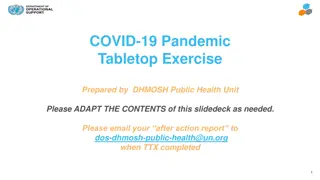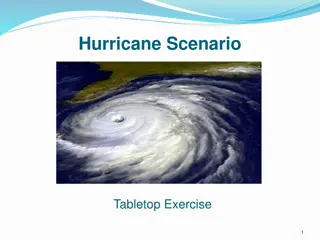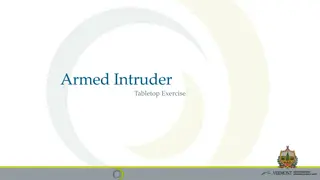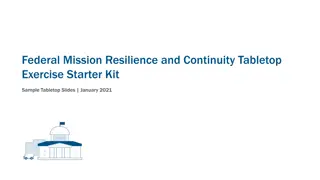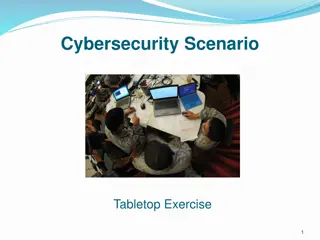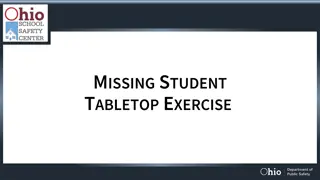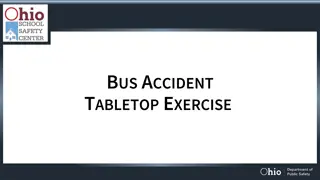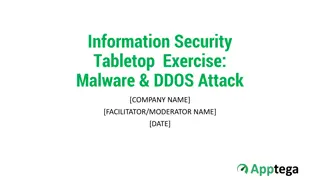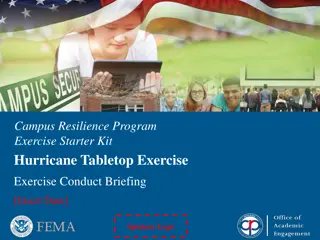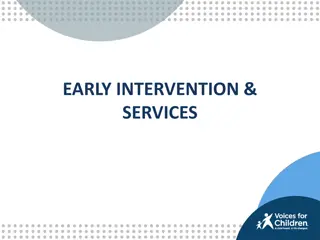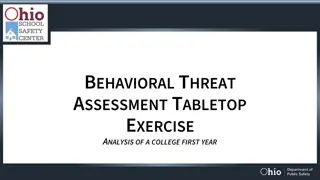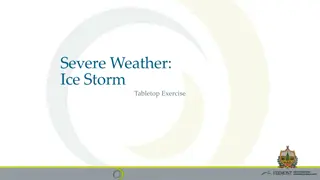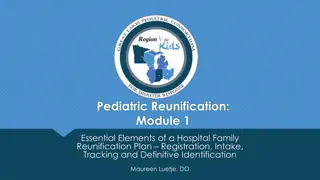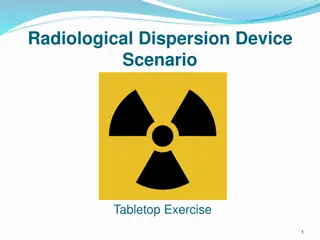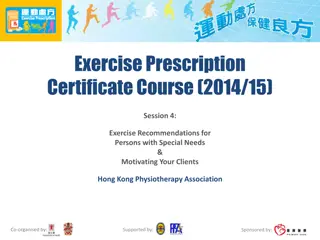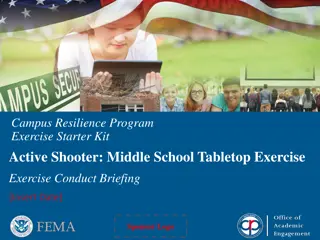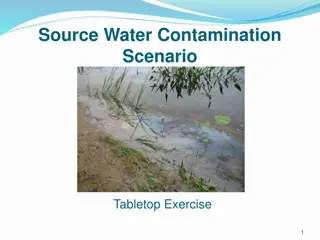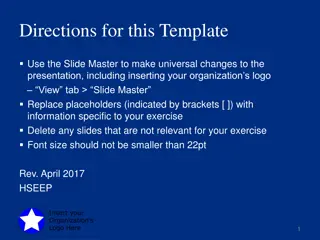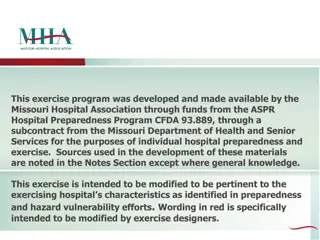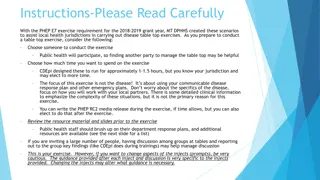Hazmat Release Reunification Tabletop Exercise Overview
This tabletop exercise focuses on preparedness for a hazmat release and subsequent reunification process near a school. The agenda includes introductions, exercise goals, objectives, participant roles, and exercise structure. The exercise aims to test controlled student reunification, assess accountability processes, evaluate communication capabilities, and define redundant notification systems. Participants will respond based on their expertise, while facilitators will guide discussions towards exercise objectives. The exercise is scenario-driven, comprising modules for response and recovery scenarios, followed by a debrief.
Download Presentation

Please find below an Image/Link to download the presentation.
The content on the website is provided AS IS for your information and personal use only. It may not be sold, licensed, or shared on other websites without obtaining consent from the author. Download presentation by click this link. If you encounter any issues during the download, it is possible that the publisher has removed the file from their server.
E N D
Presentation Transcript
Reunification Due to Hazmat Release Tabletop Exercise
Exercise Agenda Welcome and Introductions Housekeeping Exercise Overview Goals Rules Objectives/Core Capabilities Assumptions and Artificialities Roles and Responsibilities Schedule Structure Scenario-Driven Exercise Facilitated Discussion in Four Modules Hot Wash Closing Comments Debrief
Welcome and Introductions Opening Remarks Facilitator Introductions Hosting Agency Participants Exercise Staff Lead Facilitator
Exercise Goals Test plans to prepare for, respond to, and recover from the reunification process due to a hazmat release near our school. Ensure effective coordination of plans and actions with school and community partners. Strengthen relationships with our response partners. Identify areas for improvement and develop a corrective action plan.
Objectivesand Core Capabilities To test the controlled release/reunification of students to parents and/or guardians. To assess the process of accurate accountability of students and release of students to authorized adults only. To evaluate the communication capability between the command post, district office, transportation, and school or evacuation sites. To define and assess if redundant emergency notification system(s) are developed and communicated to parent/caregivers prior to an event: auto dialing; website; media partners, etc.
Participants Roles and Responsibilities Players: Respond to the situation presented, based on expert knowledge of response procedures, current plans and procedures, and insights derived from training. Facilitator(s): Responsible for moderating and keeping participant discussions focused on exercise objectives and core capabilities, and ensuring relevant issues are explored; provide situational updates and additional information; resolve questions as required.
Exercise Structure A scenario-driven, facilitated discussion-based exercise The exercise is divided in three modules: oModule 1: Initial Response Scenario Background oModule 2: Response Scenario Update #1 oModule 3: Recovery Scenario Update #2 Debrief
Rules for Players There are no right or wrong answers/ideas. Varying viewpoints are expected and will be respected. Exercise decisions are not precedent setting. Players are encouraged to consider different approaches and suggest improvements/ Think outside the box.
Ground Rules This is not a test of current capabilities and plans. It is a discussion of probable responses to a hypothetical emergency. The exercise will be an open dialogue. All ideas and input are welcome. One person speaks at a time. The scenario will be accepted as is. However, the facilitator may make modifications as deemed appropriate. No hypothetical resources are available.
Assumptions and Artificialities The exercise is conducted in a no-fault learning environment wherein capabilities, plans, systems and processes will be evaluated. Participants respond to the TTX scenario events and other exercise information from the perspective of their school s current policies, plans, processes and capabilities. The exercise scenario is plausible, and events occur as they are presented in the TTX scenario, allowing for artificialities. All players receive information at the same time.
Exercise Schedule Exercise Logistics and Set-up Registration Welcome and Introductions Exercise Overview Module 1: Initial Response Scenario Background Break Module 2: Response Module 3: Scenario Update Module 4: Recovery Break Hot Wash Closing Comments Debrief
Tabletop Processes A scenario and update statements will be used to generate discussion of probable response actions. Participants will provide situational responses based on established procedures and plans. The Emergency Operations Plan (should be) available for reference. Other than maps and diagrams, no additional materials will be provided. The exercise will conclude with development of action steps needed to support future mitigation and preparedness efforts.
Exercise Guidelines Respond based on your knowledge of your school plans and capabilities. Discuss and present multiple options and possible solutions. Be aware that each phase will not have complete resolution. Any issues that cannot be resolved within a reasonable period of time will be tabled as an after-action item. If more information is needed, ask. Assume any agencies that are requested are initiating their response plans.
Module 1 Initial Response: Scenario Background
Date: November 4thTime: 2:00 pm It is a clear, sunny Monday in November. At approximately 2:00 p.m. the school receives a call from the local fire department dispatcher advising that a hazardous materials incident has occurred near the school. Additionally, the dispatcher advises that depending upon the wind conditions, the school could be at risk from the fumes in the air.
Discussion With the information provided, what immediate action will be taken based on your EOP? Is this a situation in which evacuation of the school would be considered, or are there other options? If evacuation is chosen, where would students, faculty and staff be evacuated to? What is the transportation plan to get them there? Who will be involved in this decision making process?
Will coordination take place with other schools in the district? What will be the method of communication and coordination? Who is responsible? How will communication be continued with emergency first responders? Who is responsible for communicating with first responders? What is the school s social media policy during a situation like this?
Module 2: Response
Date: Time: The school is instructed by the fire department to evacuate to a location outside the immediate threat area. Two other schools in the district are evacuating due to the situation. Local police, EMS, and the fire department have responded to those schools to assist in the evacuation of students.
Discussion What are your procedures for transporting students away from the school during school hours? Are the buses available and able to transport all students and staff as needed? What/where are the reunification sites established in the current emergency plan? Is there at least one site far enough away from the school to allow for an incident such as this? What is your procedure for notifying and documenting the reunification of students and parents? How are parents notified of the incident and the procedure for picking up their children?
Take time now to draft your communication to parents regarding the situation, plan of action and reunification procedures.
Discussion In the past have you had a conversation with emergency first responders about where to assemble in an emergency like this? Have you thought about establishing a unified command? If so, who would be included in that command? What planning have you done to ensure that your teachers faculty, staff, and students are prepared to deal with a potential incident like this?
Module 3: Recovery
Situation Update The media has been airing live feed of the hazmat situation near the school. The school is now receiving telephone calls from concerned parents trying to find out about their children. Parents have started to arrive at the school in an attempt to get their children.
Discussion Will you coordinate your communications with the local first response agencies? Why or why not? How do you plan to communicate with your school community about this incident? Does your plan include how you will handle internal and external communications? Describe the media platforms that will be utilized for this messaging? When the incident is over, do you plan to continue with the school day? If yes, why? If no, why not? How will the school triage the potential physical and emotional needs of the students, faculty and staff?
Hotwash Did this exercise increase your awareness of school preparedness needs in a situation like this? How? Will this exercise provide input for continued emergency operations planning and coordinating with emergency response personnel in your area? How? What action steps should this group take now? What are the major lessons learned from today s discussion? What are tentative next steps to continue the discussion and address any areas of concern?
Where do we go from here? Specific Issues Identified Person assigned to follow-up Timeline of completion 3, 6, 9 months
Contact the Vermont School Safety Center Web Site Vermont School Safety Center Web Site Twitter https://twitter.com/vted_safeschool
Stay Connected With Us @margolishealy www.facebook.com/margolishealy www.linkedin.com/company/margolis-healy-&-associates



